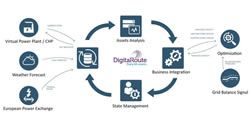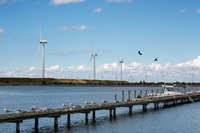Insights from Data
Solar and storage plants aren't one machine; they're actually decentralized, interconnected ecosystems. Rows of solar panels capture sunlight and generate electricity, while BESS systems store that energy in rows of batteries packed together.
EtherCAT measurement terminals in wind farm monitoring
By continuously monitoring the turbine, blades, and foundation performance, you can support decision making on planned maintenance and design validations, which in turn can help to avoid unplanned shut down periods or making costly repairs in the event of failure.
Solar Energy Production Shines Brighter With Data Analysis Tools
Many people understandably want clear ideas of the expected results before and after installation. Data analysis tools can provide that, removing much of the uncertainty that may cause customers to delay their solar energy investments.
8 Reasons to Integrate your Monitoring System with an Asset Management Software
Integration between solar and wind asset management software and monitoring software lets owners and operators automatically retrieve weather and production information, providing an up-to-date overview of the status of their portfolio.
Harnessing Alternative Data and Alternative Energy to Increase Efficiency
AI powered tools, like Dataminr, help firms make sense of the vast sets of social media data to confidently leverage information from on-the-ground events and enabling them to make the right decisions in the moment.
Digitization and the Evolving Utility: The Song Remains the Same
Energy suppliers face change. New forms of alternative energies, new network technologies and the transition to the digital world all present challenges. There are lessons to be learned about how to make the new world work.
New Database Spanning Hundreds of Wind Test Reports
One area which benefits from digitisation is the evaluation of data from periodic turbine testing and inspection reports.
A Danish Wind Turbine Maker Harnesses Data in a Push to Stay Ahead
Stanley Reed for The New York Times: A project to install hundreds of wind turbines in the Fosen peninsula area of Norway at one point was shelved as unfeasible. The strong breezes that whip off the sea can shift and swing unpredictably, while the soaring cliffs and steep drop-offs create turbulence that wears out expensive equipment.
The venture was rescued with a lot of help from the mathematical calculations of Vestas Wind Systems, a Danish wind power company. Vestas used data to figure out how to use more powerful turbines for the project, and precisely where to place them. That meant the utility developing the facility could buy fewer turbines, helping cut costs and balancing the economics of the $1.2 billion project.
The company is at the forefront of efforts to make wind a competitive source of energy, rather than just a subsidized experiment. In doing so, it has become a model for the renewables industry, which has struggled at times to remain viable while facing cuts to government subsidies and volatile oil and gas prices. Vestas understands the fickleness of the renewable energy business. Cont'd...
The Fourth Industrial Revolution in the Energy Industry
The Fourth Industrial Revolution means providing a personalised energy experience for the consumers, prosumers and utility companies. Consumers and prosumers want to see their impact on their bill, the grid and the environment - and they want to be accountable for their energy choices.
MERSEN ACHIEVES HIGH LEVEL OF COMPLIANCE IN IDEA'S DATA CERTIFICATION PROGRAM
Mersens commitment in populating the items critical fields within IDEAs Data Certification Program helps to set the bar for the level of complete data available in the IDW.
The Role of Data Analytics in Accelerating the Adoption of Solar
Data analytics help fleet owners and operators reduce costs while improving system performance, thus accelerating the adoption of solar since it can better compete with other generation sources.
Records 1 to 11 of 11
Featured Product

MORNINGSTAR - ReadyEdge
The ReadyEdgeTM (RE-1) accessory is an intelligent system controlling and reporting device meant to make monitoring your solar energy system more transparent. Enabling access to LiveViewTM 2.0 and Morningstar Solar ConnectTM, ReadyEdge provides data from all compatible Morningstar devices in your system. It is designed to be paired with the three ReadyBlock options, up to six total, with the possibility to use multiple ReadyShunts and ReadyRelays. The ReadyEdge is compatible with select Morningstar products.


).JPG)
.jpg)





